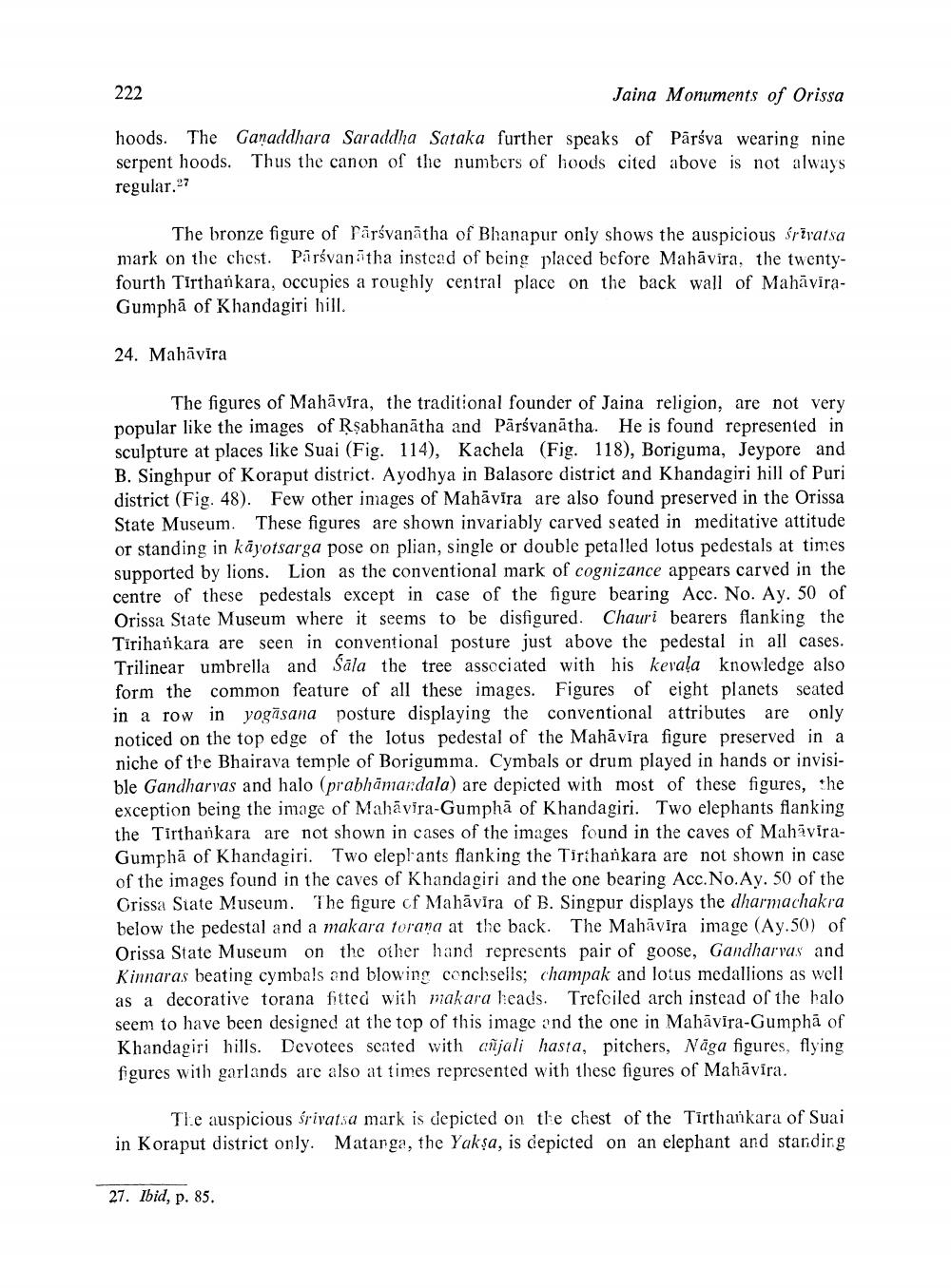________________
222
Jaina Monuments of Orissa hoods. The Ganaddhara Saraddha Sataka further speaks of Pâráva wearing nine serpent hoods. Thus the canon of the numbers of hoods cited above is not always regular.27
The bronze figure of Pārsvanātha of Bhanapur only shows the auspicious śrīvatsa mark on the chest. Pārsvanātha instead of being placed before Mahāvira, the twentyfourth Tirthankara, occupies a roughly central place on the back wall of MahāviraGumphā of Khandagiri hill.
24. Mahāvīra
The figures of Mahāvira, the traditional founder of Jaina religion, are not very popular like the images of Rşabhanātha and Pārsvanātha. He is found represented in sculpture at places like Suai (Fig. 114), Kachela (Fig. 118), Boriguma, Jeypore and B. Singhpur of Koraput district. Ayodhya in Balasore district and Khandagiri hill of Puri district (Fig. 48). Few other images of Mahāvīra are also found preserved in the Orissa State Museum. These figures are shown invariably carved seated in meditative attitude or standing in kāyotsarga pose on plian, single or double petalled lotus pedestals at times supported by lions. Lion as the conventional mark of cognizance appears carved in the centre of these pedestals except in case of the figure bearing Acc. No. Ay. 50 of Orissa State Museum where it seems to be disfigured. Chauri bearers flanking the Tīriharkara are seen in conventional posture just above the pedestal in all cases. Trilinear umbrella and Sāla the tree associated with his kevala knowledge also form the common feature of all these images. Figures of eight planets seated in a row in yogasana posture displaying the conventional attributes are only noticed on the top edge of the lotus pedestal of the Mahāvira figure preserved in a niche of the Bhairava temple of Borigumma. Cymbals or drum played in hands or invisible Gandharvas and halo (prabhāmandala) are depicted with most of these figures, the exception being the image of Mahāvira-Gumphā of Khandagiri. Two elephants flanking the Tirthankara are not shown in cases of the images found in the caves of MahaviraGumphā of Khandagiri. Two eleplants flanking the Tirthankara are not shown in case of the images found in the caves of Khandagiri and the one bearing Acc. No.Ay. 50 of the Orissa State Museum. The figure cf Mahāvīra of B. Singpur displays the dharmachakra below the pedestal and a makara torana at the back. The Mahāvira image (Ay.50) of Orissa State Museum on the other hand represents pair of goose, Gandharvas and Kinnaras beating cymbals and blowing conchsells; champak and lotus medallions as well as a decorative torana fitted with makara leads. Trefoiled arch instead of the halo seem to have been designed at the top of this image and the one in Mahāvīra-Gumphā of Khandagiri hills. Devotees seated with cñjali hasta, pitchers, Näga figures, flying figures with garlands are also at times represented with these figures of Mahāvīra.
The auspicious śrivatsa mark is depicted on the chest of the Tirthankara of Suai in Koraput district only. Matanga, the Yakşa, is depicted on an elephant and starding
27. Ibid, p. 85.




